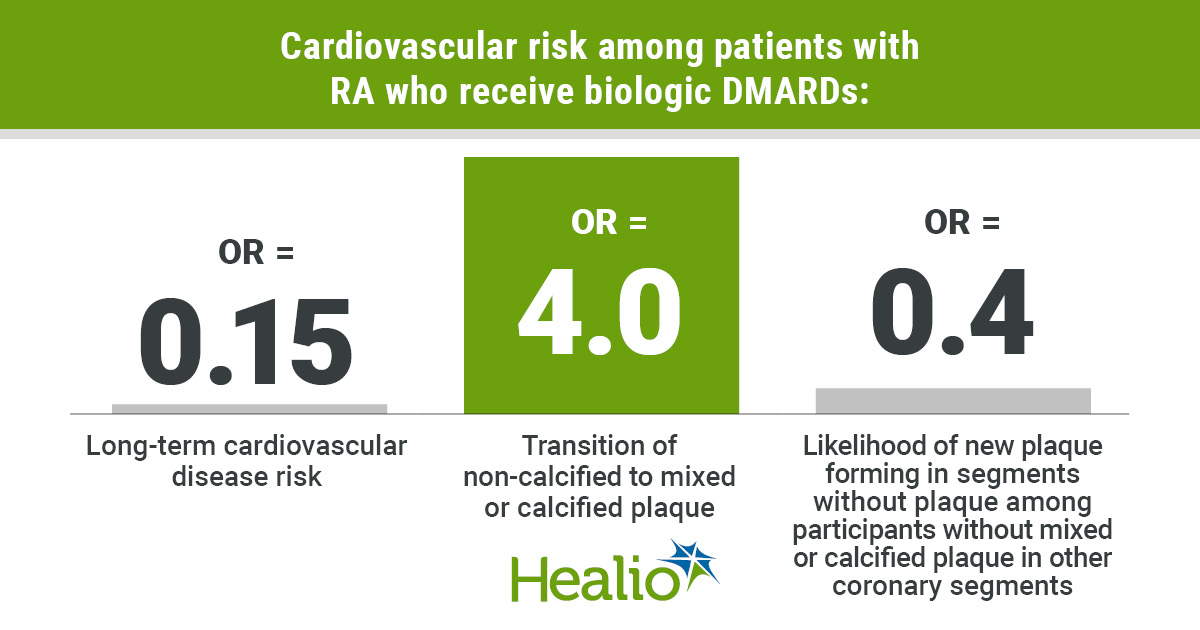Biologic DMARD use linked to lower cardiovascular risk in RA

Treatment with biologic DMARDs in patients with rheumatoid arthritis was associated with a reduced risk for cardiovascular disease, as well as protective calcification of noncalcified lesions and a lower likelihood of new plaque formation, according to data published in Arthritis & Rheumatology.
“Observational cohort studies, national registry data and meta-analyses over the years have reported overall improved cardiovascular outcomes with bDMARD therapies compared to conventional synthetic DMARDs,” George A. Karpouzas, MD, of the Harbor-UCLA Medical Center and Lundquist Institute for Biomedical Innovation, in Torrance, California, told Healio Rheumatology. “However, a mechanistic link for this observation was missing.”
To determine whether the potential cardioprotective benefits of biologic DMARDs is associated with specific effects on coronary plaque formation and progression, Karpouzas and colleagues conducted a single-center, observational cohort study of 150 patients with RA. Participants underwent computed tomography angiography for evaluation of coronary atherosclerosis, including total, noncalcified, mixed or calcified and low-attenuation plaque. A total of 101 participants completed repeat follow-ups within 6.9±0.3 years to assess plaque progression.
The researchers recorded all cardiovascular disease events prospectively, including cardiac death, myocardial infarction, unstable angina, revascularization, stroke, claudication and heart failure hospitalization. They also used the Framingham-D'Agostino score to determine cardiovascular risk, as well as segment stenosis score to measure plaque burden.

According to the researchers, current treatment with biologic DMARDs was associated with lower long-term cardiovascular disease risk (OR = 0.15; 95% CI, 0.04-0.6), after adjusting for segment stenosis score, Framingham-D'Agostino score and time-varying DAS28CRP.
“The significant cardioprotective benefits of bDMARDs against CVD events were contingent upon their current use,” Karpouzas said. “When bDMARDs were inappropriately stopped the protective effect was attenuated and significance was lost over the ensuing 6 months.”
The presence of noncalcified and low-attenuation plaque moderated the impact of biologic DMARDs on cardiovascular disease risk. In particular, biologic DMARD use was associated with lower risk in patients with noncalcified (OR = 0.21; 95% CI, 0.04-0.99) or low-attenuation plaque (OR = 0.08; 95% CI, 0.01-0.7) at baseline, but not those without.
Analyses of per-segment plaque progression demonstrated that biologic DMARDs were also associated with transition of noncalcified to mixed or calcified plaque (OR = 4; 95% CI, 1.05-15.32). Further, treatment with the drugs predicted a reduced likelihood of new plaque forming in segments without plaque among participants without mixed or calcified plaque in other coronary segments (OR = 0.4; 95% CI, 0.17-0.93), but not among those with calcification. Biologic DMARD use also predicted low-attenuation plaque loss (P = .042).
“Our study confirms the clinical benefit of bDMARDs against long-term incident cardiovascular events in a well characterized prospective RA cohort with baseline and follow-up evaluations of coronary atherosclerosis,” Karpouzas said. “It importantly provides a mechanistic explanation for the observed benefit by linking risk reduction to inhibition of new plaque formation, protective calcification of non-calcified lesions and stabilization of high-risk plaques.”

